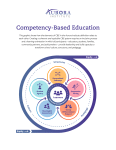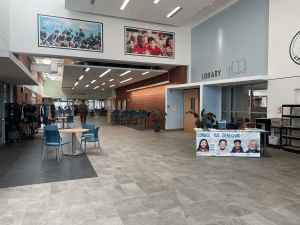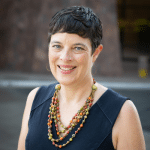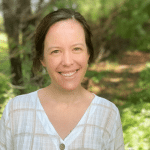Finding a Way Forward Together: Community Schools and CBE
CompetencyWorks Blog
There are many models of transformative learning that can set communities on a path towards systems transformation. That’s a good thing – we can collaborate with each other and create knowledge transfer between approaches. In an effort to bridge silos, we wanted to explore the work of community schools, a whole-community approach that aligns with the equity goals foundational to competency-based education (CBE). Additionally, many of the design principles for learning environments and instruction that are foundational to CBE complement the community school model. By taking a closer look at the work happening in community schools, we hope we can generate ideas for collaboration between innovation areas and work together to improve student learning.
Over the course of our community schools case study series, we’ll dive in and visit four learning communities to enhance our understanding of community school initiatives and how they align with CBE.

The Heart of Community Schools
Community schools have a long history that stretches back to the early 20th century, with roots in the Black community. The model emerged as a reaction to social issues like segregation and wealth inequality; social reformers recognized a need to connect students in underserved communities to resources in the larger community. Many of the values and practices of community schools also mirror traditional Indigenous education approaches. In 2023, the Brookings Institution, Coalition for Community Schools, Learning Policy Institute, and the National Center for Community Schools developed a 6-part definition of community schools that encompasses the essential practices all community schools strive to achieve:

- Integrated systems of support
- Expanded and enriched learning opportunities
- Powerful student and family engagement
- Collaborative leadership and shared power and voice
- Rigorous, community-connected classroom instruction
- A culture of belonging, safety, and care
These pillars of community schools focus on developing the whole child by listening to the needs of students and their communities. The idea that it “takes a village to raise a child” is at the heart of community schools. Schools serve an important custodial and educational function for every community. Although vital to communities, schools often lack deep connection to the neighborhoods where they’re located. Many students graduate without learning in the context of their community, and miss opportunities to use community resources. Community schools are transforming schools from siloed places of learning into community hubs where students are not alone in their learning, but receive support throughout their educational journeys.
When a child is experiencing external hardships in their life outside of school, it can be challenging to concentrate on learning. Community schools provide wraparound support services based on a whole-child and whole-community approach, that support learners so they can learn at their highest level. Wrap-around services can include health clinics and additional learning opportunities for both the child and other community members. Many community schools are open beyond the traditional school day, with services available at night, on weekends, and over school breaks. This continuity of learning and care supports children who may be navigating challenging circumstances.
Additionally, community schools often provide infrastructure for the entire community to use. For example, the school may be used for community meetings on weekends or evenings. Due to the localized nature of community schools, community schools can vary considerably from place to place and may serve their students and community differently.
In this way, the wraparound approach of community schools aligns with – though certainly doesn’t fully accomplish! – the equity goals that are also foundational to CBE.

Competency-Based Education, a Peer Model
CBE takes a personalized, student-centered approach that resonates with the six principles of community schools. Both CBE and community schools recognize that the current traditional education system is flawed in its one-size-fits-all approach and seek to transform the system into a more equitable one that meets the needs of each student. CBE focuses on ensuring learning takes place, which means that students must be able to demonstrate mastery of concepts and skills rather than receiving grades and moving on at set times.
The Aurora Institute definition of CBE incorporates seven principles:

- Essential Competencies
- Student Agency
- Differentiated Support
- Personalized Pathways
- Responsive Pacing
- Equity
- Meaningful Assessment
Equity is a leading principle of community schools and offers a clear connection with CBE. The Aurora Institute CBE definition shares an explicit commitment to equity, which aligns with the equity practices of community schools.
Strategies to ensure equity for all students are embedded in the culture, structure, and pedagogy of schools and education systems.
Both models provide guidance for designing structures that enable students to learn from where they are at, rather than expecting the same results from every learner despite starting from different places. In CBE, this might look like reforming the traditional grading system into a system that provides more information on the learner’s progress. In community schools, this might mean providing extra classes beyond the typical school day for additional support. The goal for both models is to ensure all students receive the support they need to thrive.
Community schools prioritize real-world learning opportunities and curriculum that is deeply connected to the identity of students and communities. This is one way to approach key parts of CBE, which emphasize active learning and meaningful assessments that are relevant in the real world.
Student agency manifests in both CBE and community schools. In CBE there is emphasis on the student having a voice in their learning. In community schools, the emphasis is on students having a voice in decision-making in the school, which may involve their learning.
The idea of “any time, any place” learning features in both models. By providing students with clear rubrics for competencies and learning goals, CBE creates flexibilities for how and when learning takes place. Community schools allow for more flexibility through expanded learning opportunities before and after school, on the weekends, and over the summer. Providing the infrastructure and setting students up for any time, any place learning can empower students and promote equity by providing access to different learning pathways.

Learning More About Community Schools in Practice
The synergy between community schools and CBE is an exciting frontier for the education field. By exploring our hypothesis that community schools share many principles and practices with CBE we hope to contribute to shared understanding of possible pathways to transformation and opportunities for collaboration. Beyond CBE and community schools, there is a breadth of other education models targeting similar challenges in education. Aurora’s mission includes exploring new possibilities for what learning looks like moving forward, and we hope this work builds connections throughout the education field allowing us to better learn from each other.
This series will encapsulate our learnings from the community schools we visited and we hope it will provide understanding among practitioners of community-driven and CBE school models about how the two frameworks align. Learners can benefit from both community-driven schools and competency-based education, and acknowledging there is more than one pathway to centering learners and their needs is a powerful first step for our future.

Stay tuned for our next 2 posts in the series on CICS West Belden and Winooski Middle High School.
 Gugma Vidal joined Aurora Institute in August 2024 as an intern for the CompetencyWorks program. She is currently a senior at the University of North Carolina at Chapel Hill studying Public Policy and Business Administration. She is especially interested in health equity and will be attending Emory University for her Master of Public Health in the Fall.
Gugma Vidal joined Aurora Institute in August 2024 as an intern for the CompetencyWorks program. She is currently a senior at the University of North Carolina at Chapel Hill studying Public Policy and Business Administration. She is especially interested in health equity and will be attending Emory University for her Master of Public Health in the Fall.
 Laurie Gagnon is the CompetencyWorks Program Director at the Aurora Institute. She leads the work of sharing promising practices shaping the future of K-12 personalized, competency-based education (CBE). Laurie lives in Somerville, MA with her partner, young son, and cat.
Laurie Gagnon is the CompetencyWorks Program Director at the Aurora Institute. She leads the work of sharing promising practices shaping the future of K-12 personalized, competency-based education (CBE). Laurie lives in Somerville, MA with her partner, young son, and cat.
 Kelly Organ joined the Aurora Institute as Research Manager in August 2024. She previously served as Director of Research Partnerships at a national nonprofit focused on youth well-being and social-emotional learning. Her career spans roles in service- learning, social entrepreneurship, action civics, and youth leadership programs, with a focus on developing culturally responsive and adaptable practices that support diverse learners.
Kelly Organ joined the Aurora Institute as Research Manager in August 2024. She previously served as Director of Research Partnerships at a national nonprofit focused on youth well-being and social-emotional learning. Her career spans roles in service- learning, social entrepreneurship, action civics, and youth leadership programs, with a focus on developing culturally responsive and adaptable practices that support diverse learners.